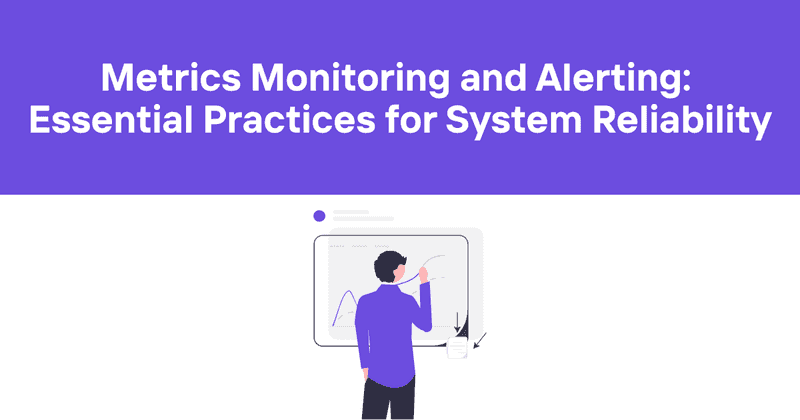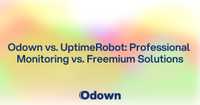Metrics Monitoring and Alerting: Essential Practices for System Reliability
When your systems fail, every second counts. That's why having proper metrics monitoring and alerting is crucial for maintaining reliable applications and infrastructure. Without visibility into what's happening, you're essentially flying blind.
I've been managing production systems for over a decade, and I've seen how the right monitoring approach can mean the difference between a minor blip and a catastrophic outage. Let's dig into what makes effective metrics monitoring and alerting work, the tools that drive modern observability, and how to avoid the all-too-common pitfalls that plague many monitoring systems.
Table of Contents
Understanding Metrics Monitoring
Metrics monitoring involves collecting, processing, and analyzing numerical data about system performance and behavior over time. Think of it as taking your system's vital signs—much like how a doctor checks your pulse, blood pressure, and temperature to assess your health.
But metrics monitoring isn't just passive observation. The "alerting" component transforms monitoring from a passive activity into an active defense mechanism for your systems.
When properly implemented, metrics monitoring provides:
- Early warning signals of system degradation before users notice
- Historical data to establish performance baselines
- Troubleshooting context during incidents
- Capacity planning insights based on usage patterns
- Validation that your system meets service level objectives (SLOs)
The goal isn't just to collect data—it's to derive actionable insights that help maintain reliable systems and drive improvements.
Key Metrics Categories to Monitor
Not all metrics are created equal. Let's break down the essential categories you should track:
Resource Utilization
These metrics tell you how your infrastructure components are performing:
- CPU usage - High CPU can indicate inefficient code or insufficient resources
- Memory consumption - Memory leaks and inefficient caching appear here
- Disk I/O and space - Often overlooked until it's too late
- Network throughput and errors - Both internal and external connectivity
- Database connections - Connection pool exhaustion is a common failure mode
Application Performance
These metrics focus on how your software is behaving:
- Request rates - How many requests your system handles
- Error rates - The percentage of requests resulting in errors
- Latency - How long operations take (p50, p95, p99 percentiles)
- Saturation - How "full" your service is
- Throughput - Work completed per unit time
Business Metrics
These connect technical performance to business outcomes:
- User logins - Authentication system health
- Conversion rates - Direct business impact
- Transaction volume - Business activity levels
- Revenue metrics - Direct financial impact
- Feature usage - Product effectiveness
External Dependencies
Your system doesn't exist in isolation:
- API call status and latency - How third-party services perform
- Payment processor availability - Critical for revenue
- CDN performance - Content delivery efficiency
- DNS resolution times - Often the first point of failure
- SSL certificate expiration - Prevents security-related outages
User Experience Metrics
These represent the actual user perspective:
- Page load time - How quickly content appears
- Time to interactive - When users can actually use your site
- Client-side errors - JavaScript exceptions
- Bounce rates - User abandonment patterns
- Session duration - Engagement levels
The metrics you choose to monitor should align with your specific system architecture and business goals. Start with the basics, then expand as you learn what's most meaningful for your environment.
Building Effective Alerts
Collecting metrics is only half the battle. The real value comes from knowing when those metrics indicate a problem.
Alert Design Principles
Good alerts should be:
- Actionable - Trigger only when someone needs to take action
- Accurate - Minimize false positives and negatives
- Clear - Provide enough context to understand the problem
- Relevant - Target the right responders
- Timely - Provide enough warning to prevent or mitigate issues
Bad alerts waste people's time and lead to alert fatigue. As one client told me after we revamped their alerting system, "Now I actually look at my phone when it buzzes instead of assuming it's another false alarm."
Alert Types and Thresholds
Different situations call for different alert types:
- Static thresholds - Good for metrics with predictable acceptable ranges
- Dynamic thresholds - Adapt to changing patterns in your data
- Anomaly detection - Flag unusual patterns that may indicate problems
- Compound alerts - Trigger based on multiple conditions
- Trend-based alerts - React to concerning directional changes
Setting appropriate thresholds is both art and science. Too sensitive, and you'll drown in noise. Too forgiving, and you'll miss critical issues.
Here's a simple example of threshold setting for a web service:
| Metric | Warning Threshold | Critical Threshold | Response Time |
|---|---|---|---|
| CPU Utilization | >70% for 5 min | >90% for 2 min | Immediate |
| Error Rate | >1% for 5 min | >5% for 1 min | Immediate |
| Latency (p95) | >500ms for 10 min | >1s for 3 min | Immediate |
| Disk Space | <20% free | <10% free | Within 4 hours |
| SSL Cert Expiry | <30 days | <7 days | Within 24 hours |
When setting thresholds, consider:
- Historical performance data
- Business impact of issues
- Recovery time objectives
- Available response resources
- Time of day/week (for seasonality)
Alert Severity Levels
Not all alerts warrant a 3 AM wake-up call. Consider implementing a severity system:
- Critical - Requires immediate attention, impacts users or business
- Warning - Needs attention soon but isn't immediately impacting users
- Info - Something to be aware of but doesn't require action
Document clear definitions of each level and ensure your team understands when to use each.
Metrics Collection Strategies
Gathering metrics effectively requires thoughtful implementation.
Push vs. Pull Models
There are two primary approaches to metrics collection:
Pull-based systems (like Prometheus):
- Central server scrapes metrics from targets
- Targets expose metrics endpoints
- Simpler service implementation
- Better control over collection intervals
- Challenge: Firewall/network complexities
Push-based systems (like Graphite):
- Services push metrics to collectors
- Works better across network boundaries
- Easier for ephemeral services (short-lived containers)
- Challenge: Potential data loss during collector outages
Many modern architectures use a hybrid approach—choose what makes sense for your environment.
Sampling and Aggregation
Not every data point needs to be stored forever:
- Sampling - Record a representative subset of data points
- Aggregation - Combine data into summaries (averages, percentiles, etc.)
- Resolution adjustment - Store recent data at high resolution, older data at lower resolution
These techniques help balance storage costs with data fidelity. Just be careful not to aggregate away important signals.
Tagging and Dimensionality
Adding context to metrics through tags/labels transforms simple numbers into powerful analytical tools:
- Service identifiers - Which service generated the metric
- Environment - Production, staging, development
- Region/zone - Geographical or logical deployment location
- Customer/tenant - For multi-tenant systems
- Version - Code or configuration version
Tags allow you to slice and dice metrics for troubleshooting ("Is this problem affecting all regions or just us-east-1?") and reporting ("How does our premium tier performance compare to our basic tier?").
But watch for cardinality explosion—too many unique combinations of tags can overwhelm your monitoring system.
Visualization and Dashboards
Raw numbers rarely tell the complete story. Visualization brings metrics to life.
Dashboard Types
Different audiences need different views:
- Operational dashboards - Real-time system health for operators
- Executive dashboards - High-level business metrics for leadership
- Service dashboards - Detailed metrics for specific services
- Customer dashboards - External-facing metrics for clients
Each serves a different purpose and should be designed accordingly.
Effective Visualization Techniques
Creating useful dashboards is a skill:
- Contextual presentation - Show thresholds alongside current values
- Correlation - Place related metrics near each other
- Consistency - Use similar scales and colors for comparable metrics
- Clarity - Avoid chart junk and excessive decoration
- Focus - Highlight what matters, mute what doesn't
And don't forget that the best dashboard is often the one you never need to look at because your alerts are working properly.
Common Dashboard Mistakes
I've seen many dashboards that look impressive but provide little value. Common issues include:
- Too much information on a single screen
- Lack of context for interpreting values
- Inconsistent time ranges across charts
- Missing annotations for events and changes
- Emphasizing aesthetics over utility
Remember that dashboards are tools, not artwork. They should help solve problems, not just look pretty.
Alert Fatigue and Management
Alert fatigue is the condition where teams become desensitized to alerts due to frequency, false positives, or lack of actionability. It's dangerous because it leads to ignored alerts—even important ones.
Reducing Alert Noise
To combat alert fatigue:
- Eliminate redundant alerts - If five services depend on a database, you don't need five alerts when it goes down
- Group related alerts - Combine multiple related issues into a single notification
- Implement alert suppression - During known issues or maintenance
- Create runbooks - Clear instructions for common alerts
- Use alert routing - Send different alerts to different teams
- Implement time-based policies - Some issues can wait until morning
One effective approach is to audit your alerts quarterly: Which alerts resulted in action? Which were ignored? This data helps refine your alerting strategy.
On-Call Rotation and Handoff
Even with the best alert management, someone needs to respond when things break:
- Establish clear schedules - People should know exactly when they're responsible
- Define escalation paths - What happens if the primary responder doesn't acknowledge?
- Document handoff procedures - Ensure context transfers between shifts
- Create incident commander roles - Someone to coordinate during major incidents
- Review on-call burden - Ensure it's distributed fairly
The most successful teams treat on-call as a shared responsibility, not a punishment assigned to junior engineers.
Incident Response and Escalation
When alerts fire, what happens next? Having a clear incident response process is crucial.
Incident Classification
Start by classifying incidents:
- P1 - Critical business impact, all hands on deck
- P2 - Significant impact, needs urgent attention
- P3 - Limited impact, needs attention during business hours
- P4 - Minor issue, can be scheduled for future work
Each level should have clear definitions and response expectations.
Escalation Procedures
Define how incidents move through your organization:
- Initial response - First responder acknowledges and begins investigation
- Technical escalation - Bringing in subject matter experts
- Management escalation - Keeping leadership informed
- External escalation - Involving vendors or partners
- Customer communication - Keeping users informed
Document these procedures before you need them—during a crisis is the worst time to figure out who to call.
Post-Incident Analysis
After the dust settles, learning from incidents is critical:
- Blameless postmortems - Focus on systems and processes, not individuals
- Root cause analysis - Dig beyond symptoms to underlying issues
- Corrective actions - Specific, assigned improvements
- Monitoring improvements - Would better alerting have caught this sooner?
Each incident should make your system more resilient, not just return it to the previous state.
Tools for Metrics Monitoring
The monitoring landscape is vast. Here's an overview of popular options:
Open Source Solutions
- Prometheus - Pull-based monitoring with a powerful query language
- Grafana - Visualization platform that works with multiple data sources
- Nagios - Veteran monitoring platform focused on availability
- Zabbix - Comprehensive monitoring for networks and applications
- Graphite - Time-series database with rendering capabilities
Commercial Platforms
- Datadog - Cloud-scale monitoring with broad integration support
- New Relic - Application and infrastructure monitoring
- Dynatrace - AI-powered full-stack monitoring
- AppDynamics - Application performance monitoring with business context
- Splunk - Data platform that can incorporate metrics and logs
Cloud Provider Solutions
- AWS CloudWatch - Native monitoring for AWS resources
- Google Cloud Monitoring - Stackdriver for Google Cloud
- Azure Monitor - Microsoft's monitoring solution
- Oracle Cloud Monitoring - For Oracle Cloud infrastructure
The "best" tool depends on your specific requirements, existing infrastructure, and team expertise. Many organizations use multiple tools for different aspects of monitoring.
Setting Up Monitoring in Different Environments
Monitoring needs vary across environments.
On-Premises
Traditional data centers require:
- Hardware-level monitoring (temperature, power, network)
- Agent-based collection on servers
- Network monitoring devices
- Local storage and retention policies
Cloud-Native
Cloud environments benefit from:
- Integration with cloud provider metrics
- Auto-discovery of resources
- Elastic scaling of monitoring infrastructure
- Focus on service-level metrics over hardware
Hybrid Scenarios
Many organizations operate in hybrid mode:
- Unified view across environments
- Consistent naming and tagging
- Normalized metrics across platforms
- Centralized alerting regardless of source
Containerized Environments
Containers present unique challenges:
- Ephemeral nature requires different collection approaches
- Service discovery becomes essential
- Container-specific metrics (orchestration, restarts)
- Higher cardinality due to instance proliferation
The key is designing your monitoring to match your deployment model while maintaining consistent visibility regardless of where workloads run.
Common Pitfalls in Metrics Monitoring
Even experienced teams make these mistakes:
Vanity Metrics
Tracking metrics that look good but don't provide actionable insights. For example, total number of users might be interesting but doesn't tell you if your system is healthy.
Overlooking Business Context
Technical metrics without business context lack meaning. A 100ms latency increase might be catastrophic for a trading platform but insignificant for a content site.
Too Many Metrics
Collecting everything "just in case" leads to noise and storage costs. Be intentional about what you track.
Inadequate Documentation
When a critical alert fires at 3 AM, unclear documentation extends downtime.
Ignoring the User Perspective
Internal metrics looking good doesn't guarantee users are having a good experience. Supplement with synthetic and real user monitoring.
Siloed Monitoring
Different teams using different, disconnected monitoring systems makes correlation difficult.
Insufficient Testing
Monitoring systems themselves can fail. Test your alerts regularly—can you verify they'll fire when needed?
Best Practices for Modern Monitoring
Here are field-tested approaches that work:
- Start with the user experience and work backward to technical metrics
- Define and track SLOs (Service Level Objectives) for key user journeys
- Implement the USE method for resources: Utilization, Saturation, Errors
- Follow the RED method for services: Rate, Errors, Duration
- Create clear ownership of services and their metrics
- Automate remediation where possible for common issues
- Build monitoring as code alongside your infrastructure
- Correlate metrics with logs and traces for full observability
- Practice chaos engineering to verify monitoring effectiveness
- Continuously improve based on incidents
Remember that perfect monitoring doesn't exist—it's always evolving as your systems and understanding grow.
The Future of Metrics Monitoring
The monitoring landscape continues to evolve:
AI and ML Integration
Machine learning is transforming monitoring:
- Anomaly detection without manual thresholds
- Automatic correlation of related issues
- Predictive alerts before problems occur
- Noise reduction through pattern recognition
Observability Beyond Monitoring
The observability movement expands our view:
- From known metrics to unknown questions
- Greater emphasis on traces and events
- Deeper understanding of system behavior
- Exploration capabilities beyond dashboards
Distributed Systems Complexity
As systems become more distributed:
- Service maps visualize dependencies
- Distributed tracing tracks requests across services
- Metrics collection at unprecedented scale
- Focus on global health over individual components
Human-Centered Alerting
The future focuses more on responder experience:
- Context-aware notification timing
- Personalized alert delivery
- Mental health considerations in on-call design
- Automated enrichment with relevant information
The most successful organizations treat their monitoring systems as products—continuously improved based on user feedback and changing needs.
Monitoring with Odown
While implementing a comprehensive metrics monitoring system can seem daunting, tools like Odown simplify the process significantly.
Odown provides essential monitoring capabilities:
- Website and API monitoring with customizable check frequencies
- Multi-location checks to verify global availability
- SSL certificate monitoring to prevent security-related outages
- Public status pages for transparent communication during incidents
For developers looking to establish reliable monitoring without building complex infrastructure, Odown offers an accessible entry point with key features:
- Instant alerts via multiple channels (email, SMS, Slack)
- Historical uptime data for performance analysis
- Simple integration with existing workflows
- Comprehensive SSL monitoring including expiration tracking
The most effective monitoring strategy often combines purpose-built tools like Odown for specific use cases (uptime, SSL) with broader metrics systems for deep infrastructure visibility.
By starting with critical path monitoring through Odown and expanding as needs grow, teams can establish reliable alerting without overwhelming complexity. The transparent status page functionality also helps maintain user trust during inevitable incidents by providing clear, timely updates.
Whether you're just beginning your monitoring journey or looking to enhance specific aspects of your observability strategy, tools like Odown can play an important role in maintaining system reliability and security.
Effective metrics monitoring and alerting isn't just a technical requirement—it's a competitive advantage. Organizations that can detect and resolve issues before users notice demonstrate a commitment to quality that builds trust and retention.
By thoughtfully implementing the strategies outlined here, you'll not only reduce downtime and improve performance but also create a more sustainable operational environment for your team. The initial investment in proper monitoring pays dividends through faster resolution times, fewer user-impacting incidents, and less stressful on-call experiences.
Remember that metrics monitoring is a journey, not a destination. Start with the basics, focus on what matters most to your users, and continuously refine your approach as you learn.



